Kento Kawaharazuka
M3D-skin: Multi-material 3D-printed Tactile Sensor with Hierarchical Infill Structures for Pressure Sensing
Oct 14, 2025Abstract:Tactile sensors have a wide range of applications, from utilization in robotic grippers to human motion measurement. If tactile sensors could be fabricated and integrated more easily, their applicability would further expand. In this study, we propose a tactile sensor-M3D-skin-that can be easily fabricated with high versatility by leveraging the infill patterns of a multi-material fused deposition modeling (FDM) 3D printer as the sensing principle. This method employs conductive and non-conductive flexible filaments to create a hierarchical structure with a specific infill pattern. The flexible hierarchical structure deforms under pressure, leading to a change in electrical resistance, enabling the acquisition of tactile information. We measure the changes in characteristics of the proposed tactile sensor caused by modifications to the hierarchical structure. Additionally, we demonstrate the fabrication and use of a multi-tile sensor. Furthermore, as applications, we implement motion pattern measurement on the sole of a foot, integration with a robotic hand, and tactile-based robotic operations. Through these experiments, we validate the effectiveness of the proposed tactile sensor.
Vision-Language-Action Models for Robotics: A Review Towards Real-World Applications
Oct 08, 2025Abstract:Amid growing efforts to leverage advances in large language models (LLMs) and vision-language models (VLMs) for robotics, Vision-Language-Action (VLA) models have recently gained significant attention. By unifying vision, language, and action data at scale, which have traditionally been studied separately, VLA models aim to learn policies that generalise across diverse tasks, objects, embodiments, and environments. This generalisation capability is expected to enable robots to solve novel downstream tasks with minimal or no additional task-specific data, facilitating more flexible and scalable real-world deployment. Unlike previous surveys that focus narrowly on action representations or high-level model architectures, this work offers a comprehensive, full-stack review, integrating both software and hardware components of VLA systems. In particular, this paper provides a systematic review of VLAs, covering their strategy and architectural transition, architectures and building blocks, modality-specific processing techniques, and learning paradigms. In addition, to support the deployment of VLAs in real-world robotic applications, we also review commonly used robot platforms, data collection strategies, publicly available datasets, data augmentation methods, and evaluation benchmarks. Throughout this comprehensive survey, this paper aims to offer practical guidance for the robotics community in applying VLAs to real-world robotic systems. All references categorized by training approach, evaluation method, modality, and dataset are available in the table on our project website: https://vla-survey.github.io .
MEVITA: Open-Source Bipedal Robot Assembled from E-Commerce Components via Sheet Metal Welding
Aug 25, 2025Abstract:Various bipedal robots have been developed to date, and in recent years, there has been a growing trend toward releasing these robots as open-source platforms. This shift is fostering an environment in which anyone can freely develop bipedal robots and share their knowledge, rather than relying solely on commercial products. However, most existing open-source bipedal robots are designed to be fabricated using 3D printers, which limits their scalability in size and often results in fragile structures. On the other hand, some metal-based bipedal robots have been developed, but they typically involve a large number of components, making assembly difficult, and in some cases, the parts themselves are not readily available through e-commerce platforms. To address these issues, we developed MEVITA, an open-source bipedal robot that can be built entirely from components available via e-commerce. Aiming for the minimal viable configuration for a bipedal robot, we utilized sheet metal welding to integrate complex geometries into single parts, thereby significantly reducing the number of components and enabling easy assembly for anyone. Through reinforcement learning in simulation and Sim-to-Real transfer, we demonstrated robust walking behaviors across various environments, confirming the effectiveness of our approach. All hardware, software, and training environments can be obtained from https://github.com/haraduka/mevita .
KLEIYN : A Quadruped Robot with an Active Waist for Both Locomotion and Wall Climbing
Jul 09, 2025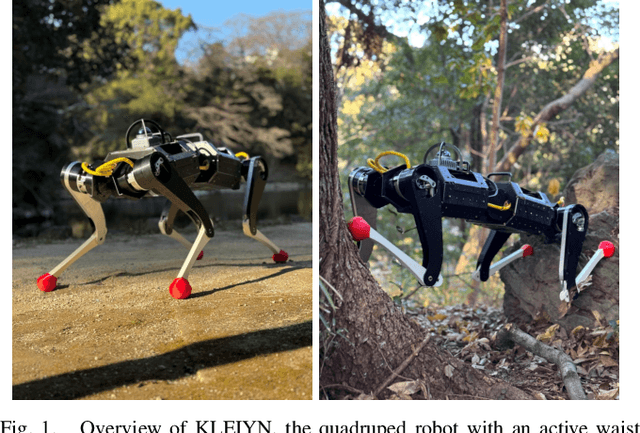
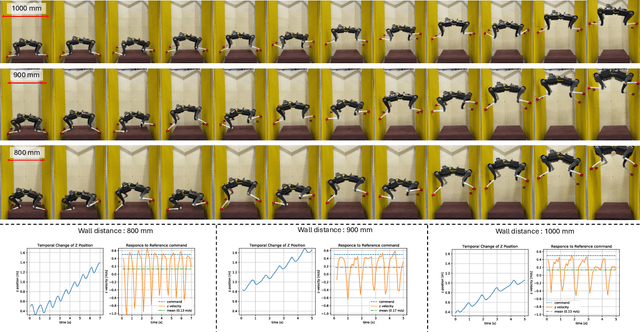
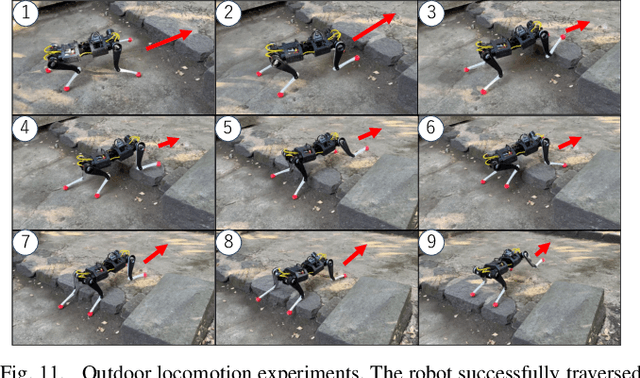
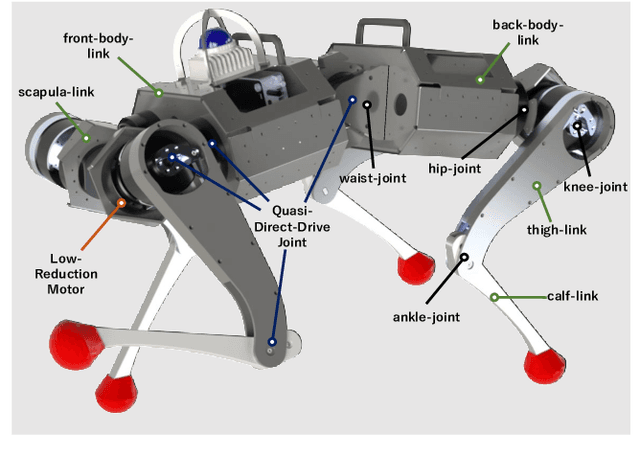
Abstract:In recent years, advancements in hardware have enabled quadruped robots to operate with high power and speed, while robust locomotion control using reinforcement learning (RL) has also been realized. As a result, expectations are rising for the automation of tasks such as material transport and exploration in unknown environments. However, autonomous locomotion in rough terrains with significant height variations requires vertical movement, and robots capable of performing such movements stably, along with their control methods, have not yet been fully established. In this study, we developed the quadruped robot KLEIYN, which features a waist joint, and aimed to expand quadruped locomotion by enabling chimney climbing through RL. To facilitate the learning of vertical motion, we introduced Contact-Guided Curriculum Learning (CGCL). As a result, KLEIYN successfully climbed walls ranging from 800 mm to 1000 mm in width at an average speed of 150 mm/s, 50 times faster than conventional robots. Furthermore, we demonstrated that the introduction of a waist joint improves climbing performance, particularly enhancing tracking ability on narrow walls.
Stability Recognition with Active Vibration for Bracing Behaviors and Motion Extensions Using Environment in Musculoskeletal Humanoids
Feb 22, 2025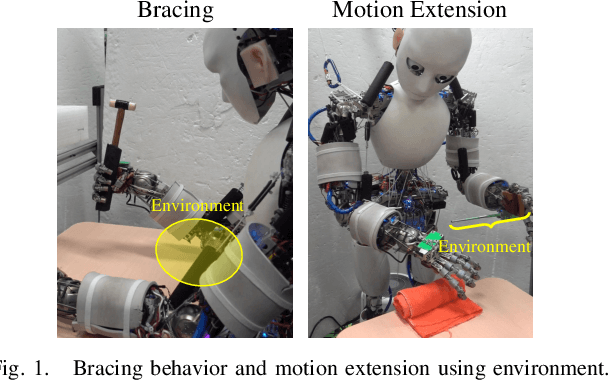
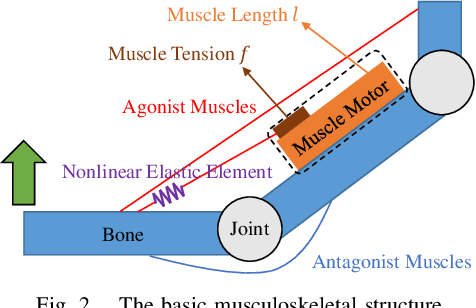
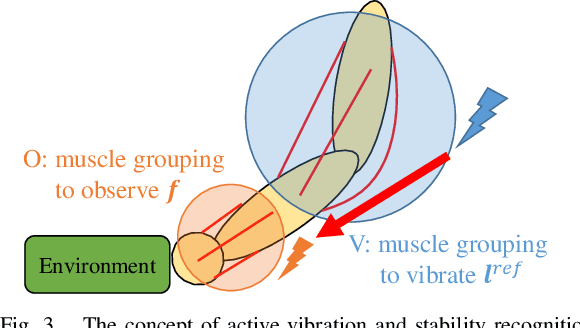
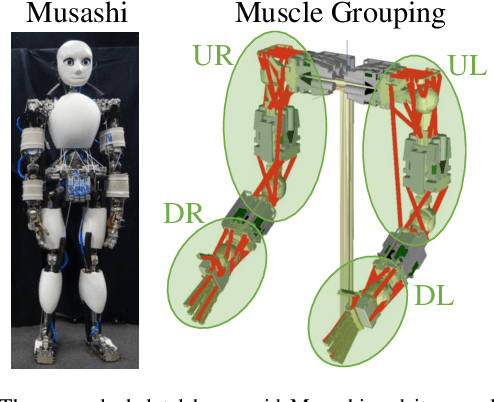
Abstract:Although robots with flexible bodies are superior in terms of the contact and adaptability, it is difficult to control them precisely. On the other hand, human beings make use of the surrounding environments to stabilize their bodies and control their movements. In this study, we propose a method for the bracing motion and extension of the range of motion using the environment for the musculoskeletal humanoid. Here, it is necessary to recognize the stability of the body when contacting the environment, and we develop a method to measure it by using the change in sensor values of the body when actively vibrating a part of the body. Experiments are conducted using the musculoskeletal humanoid Musashi, and the effectiveness of this method is confirmed.
Online Learning of Danger Avoidance for Complex Structures of Musculoskeletal Humanoids and Its Applications
Feb 22, 2025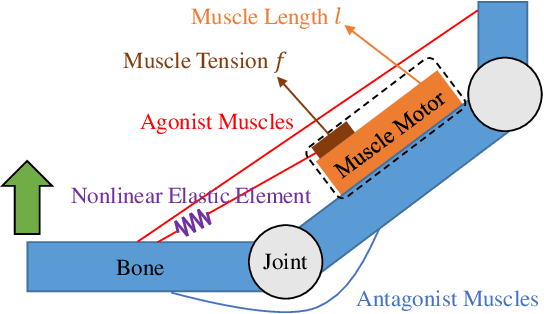
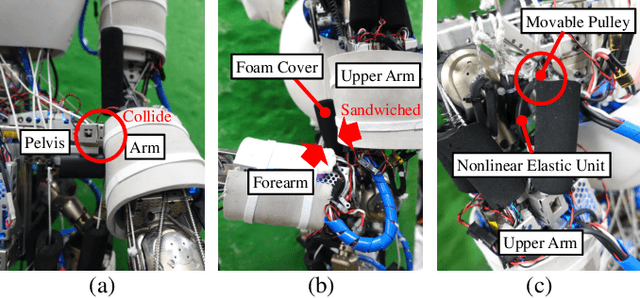

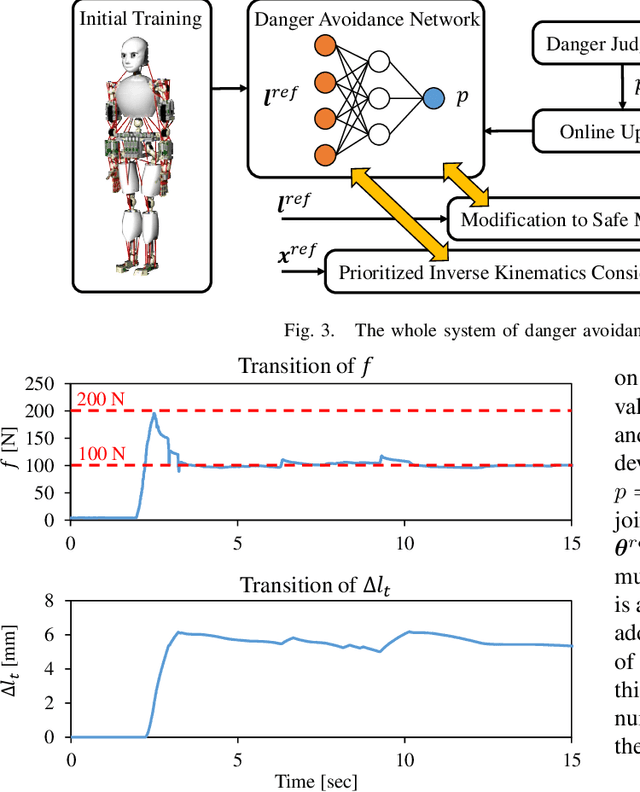
Abstract:The complex structure of musculoskeletal humanoids makes it difficult to model them, and the inter-body interference and high internal muscle force are unavoidable. Although various safety mechanisms have been developed to solve this problem, it is important not only to deal with the dangers when they occur but also to prevent them from happening. In this study, we propose a method to learn a network outputting danger probability corresponding to the muscle length online so that the robot can gradually prevent dangers from occurring. Applications of this network for control are also described. The method is applied to the musculoskeletal humanoid, Musashi, and its effectiveness is verified.
Reflex-based Motion Strategy of Musculoskeletal Humanoids under Environmental Contact Using Muscle Relaxation Control
Feb 22, 2025Abstract:The musculoskeletal humanoid can move well under environmental contact thanks to its body softness. However, there are few studies that actively make use of the environment to rest its flexible musculoskeletal body. Also, its complex musculoskeletal structure is difficult to modelize and high internal muscle tension sometimes occurs. To solve these problems, we develop a muscle relaxation control which can minimize the muscle tension by actively using the environment and inhibit useless internal muscle tension. We apply this control to some basic movements, the motion of resting the arms on the desk, and handle operation, and verify its effectiveness.
Applications of Stretch Reflex for the Upper Limb of Musculoskeletal Humanoids: Protective Behavior, Postural Stability, and Active Induction
Feb 18, 2025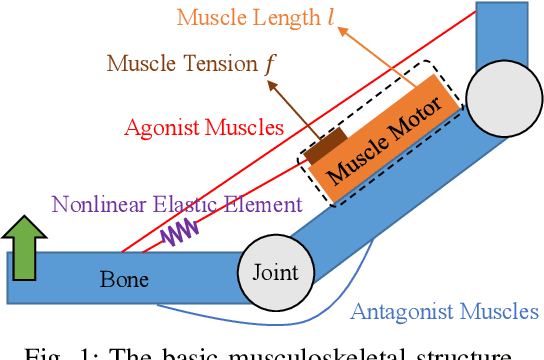
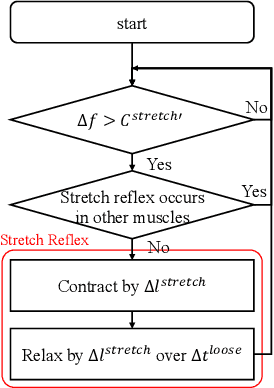
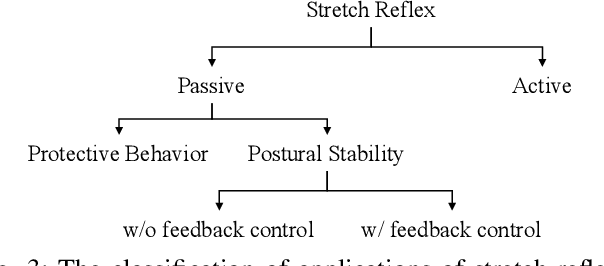
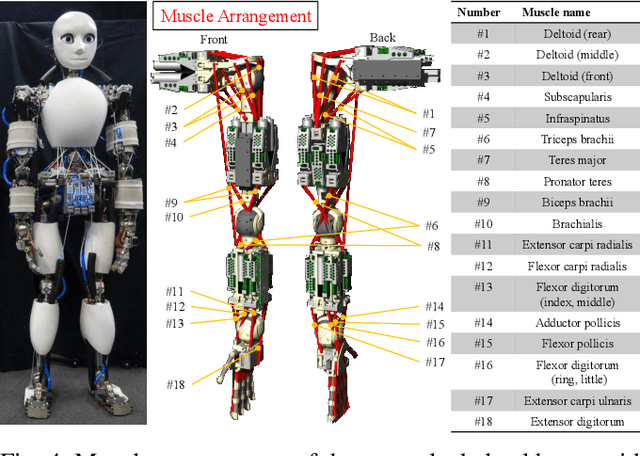
Abstract:The musculoskeletal humanoid has various biomimetic benefits, and it is important that we can embed and evaluate human reflexes in the actual robot. Although stretch reflex has been implemented in lower limbs of musculoskeletal humanoids, we apply it to the upper limb to discover its useful applications. We consider the implementation of stretch reflex in the actual robot, its active/passive applications, and the change in behavior according to the difference of parameters.
Exceeding the Maximum Speed Limit of the Joint Angle for the Redundant Tendon-driven Structures of Musculoskeletal Humanoids
Feb 18, 2025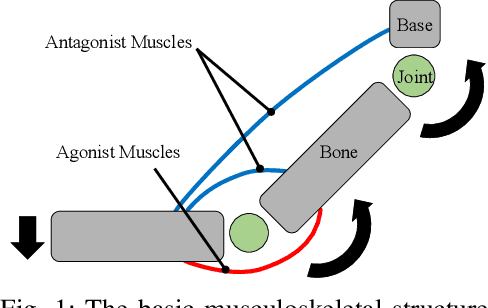
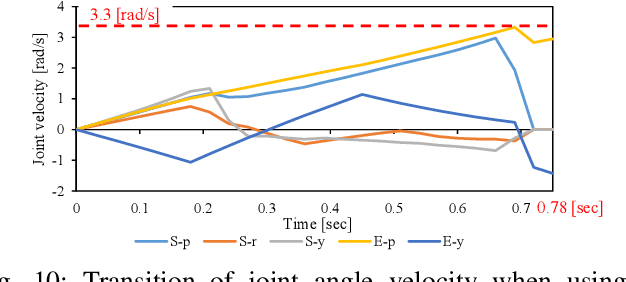
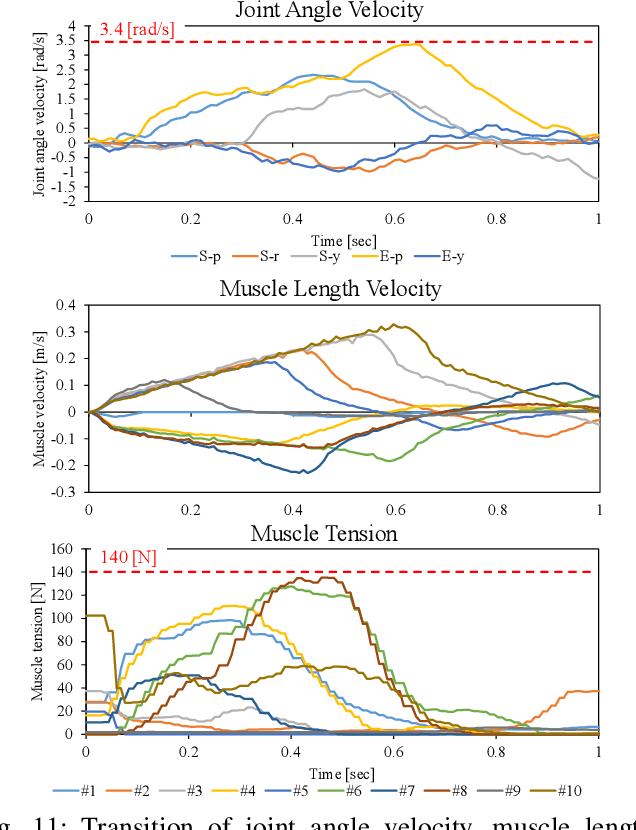
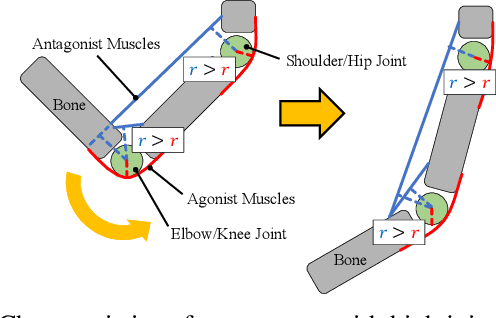
Abstract:The musculoskeletal humanoid has various biomimetic benefits, and the redundant muscle arrangement is one of its most important characteristics. This redundancy can achieve fail-safe redundant actuation and variable stiffness control. However, there is a problem that the maximum joint angle velocity is limited by the slowest muscle among the redundant muscles. In this study, we propose two methods that can exceed the limited maximum joint angle velocity, and verify the effectiveness with actual robot experiments.
Design Optimization of Musculoskeletal Humanoids with Maximization of Redundancy to Compensate for Muscle Rupture
Feb 18, 2025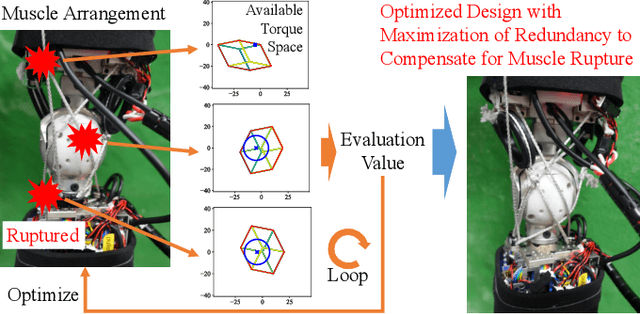

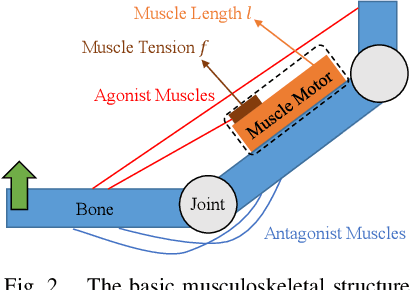
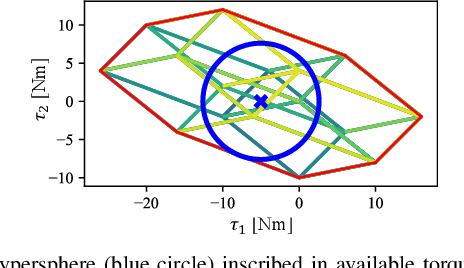
Abstract:Musculoskeletal humanoids have various biomimetic advantages, and the redundant muscle arrangement allowing for variable stiffness control is one of the most important. In this study, we focus on one feature of the redundancy, which enables the humanoid to keep moving even if one of its muscles breaks, an advantage that has not been dealt with in many studies. In order to make the most of this advantage, the design of muscle arrangement is optimized by considering the maximization of minimum available torque that can be exerted when one muscle breaks. This method is applied to the elbow of a musculoskeletal humanoid Musashi with simulations, the design policy is extracted from the optimization results, and its effectiveness is confirmed with the actual robot.
 Add to Chrome
Add to Chrome Add to Firefox
Add to Firefox Add to Edge
Add to Edge